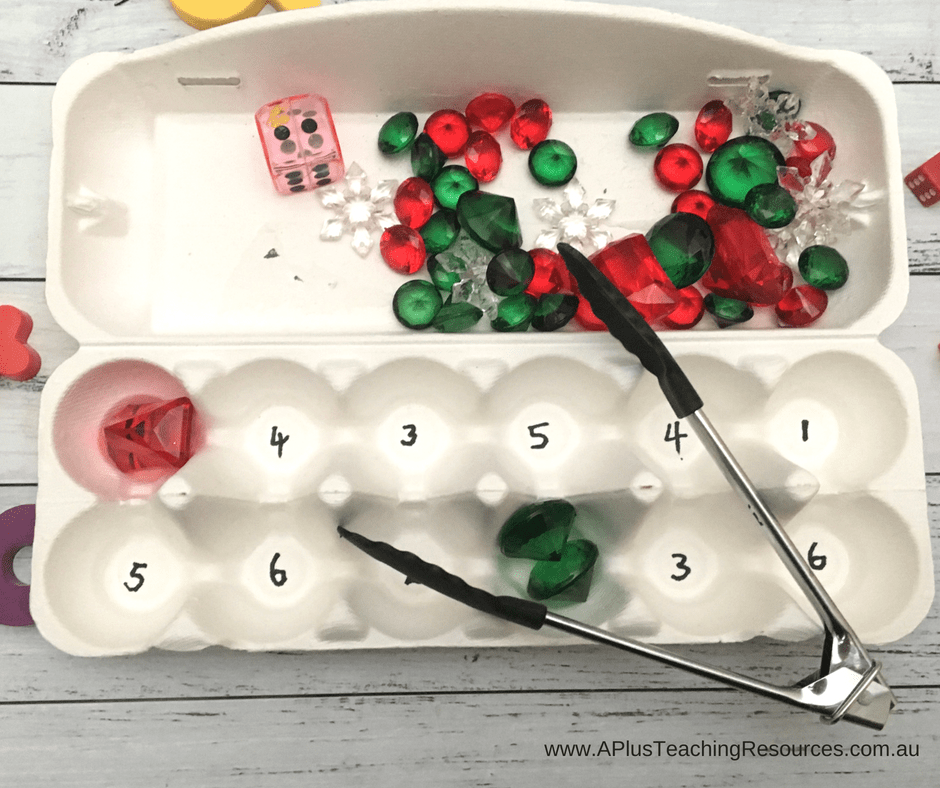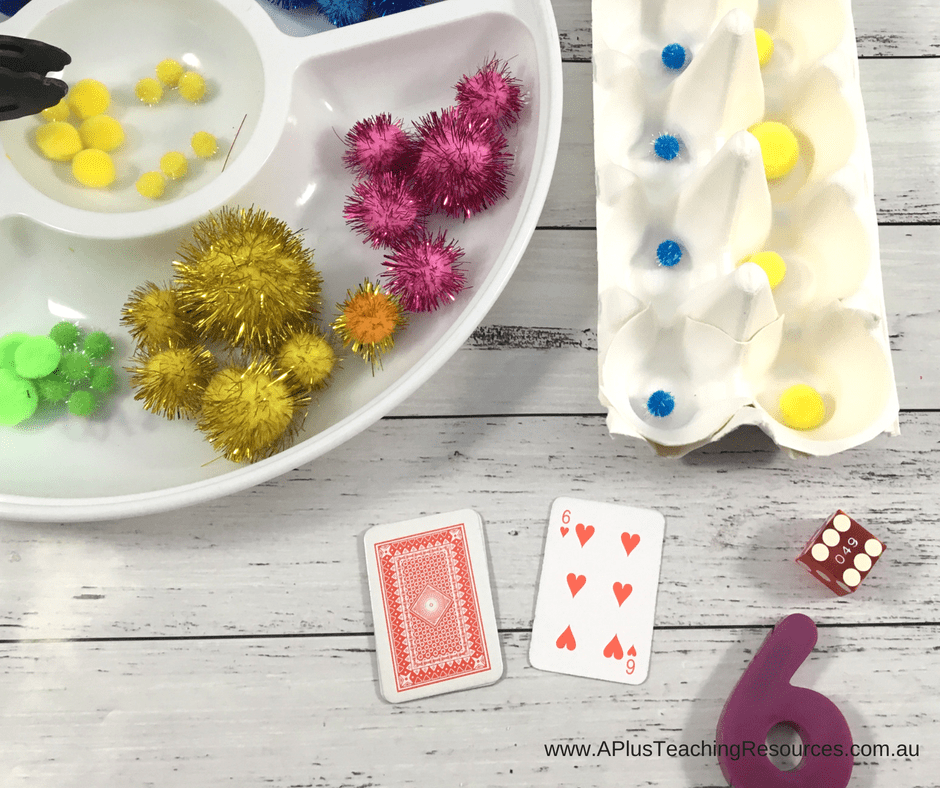These Egg Carton Addition Teaching Ideas are a fun and engaging way for kids to learn and practice early years addition skills. This everyday item makes math rotations cheap, fun and hands-on for Preschool, Kindergarten & Foundation Years kids.
Make these egg carton addition teaching ideas to use in your math rotations in a matter of minutes using everyday objects including, egg cartons, dice, counters and pompoms. Our egg carton maths activities are an engaging way to review, practice number recognition and consolidate so many early math concepts! Try them with your class today!

*This page contains affiliate links. It will not affect your buying experience. A Plus Teaching Resources may get a small commission for referring your purchase.
Egg Carton Addition Teaching Ideas

Equipment
- Egg Cartons
- Tongs
- Dice
- Permanent Markers
- Pom Poms, Gems, Dried Beans or similar objects
Preparation
- Decide which digits you are focussing on making sure you have matching dice
- Prepare you egg carton by writing the digits you are focussing on, with a permanent marker, inside the egg carton.We used a six sided dice so we focussed on the numerals 1-6 .
- You can write the numbers in order forwards on the first row and backwards on the second row or mixed up with 2 of each digit, however you think works best for your kids. You could also write the numbers on a round dot label or sticker and stick it in the egg holders, if you like so you can use the egg carton more than once!
Egg Carton Addition Teaching Ideas
The aim of this version of the game is to practice simple addition. Students will learn that addition is the process of joining quantities together to find out “how many there are”.
In this math game kids are given the opportunity to practice and consolidate a range of early years addition skills including:
- Representing situations to model and solve addition problems using physical objects
- Counting out objects rather than counting objects in a line
- Combining two or more groups of objects to find out how many there are in total
- Subitising standard dot formations for the digits 1-6
- Counting including one-to-one correspondence, learning the number names, practicing the counting sequence, learning that when we count we say numbers in the same sequence, and that the last number said when counting tells us “how many” (3 of the 5 Counting Principles). Read More about this here
- Matching digits to quantities
Click The Images To Take A Peek At Our Our Number Recognition Products…
Egg Carton Addition
Game 1
This is a very simple game but if done right can be very powerful for helping understand the addition process. When planning your activities it is important to clearly identify what your focus or learning intention is so that you select appropriate activities to help build the outcome.

For this activity we were focussing on the addition process or the combining of amounts. We are not focussing on building the recall of basic addition facts.
To make sure we provided the opportunity for a students to develop additive understanding we deliberately chose to use one dice for this addition activity.
This helps the children to focus on the addition concept of combining amounts of something to find out how many. They were able to practice the process of combining “some” to “some more”.
Once this concept is understood you could then extend the activity to adding 3 or more quantities together.
How To Play
- Roll one dice to generate how many.
- Find the matching digits in the egg carton.
- Use the tongs to pick up the gems, beans or pompoms (whatever you’re using) to count out the right number of items to match the numbers rolled on the dice. (E.g. in the image a 2 is rolled so 2 gems are counted into an egg compartment with the number 2 written in it. Next a one was rolled ad one gem was counted into the egg box.)
- Then count them all up to find out ‘how many altogether’.
Egg Carton Addition
Game 2
For Game 2 we focussed on adding two amounts using a ten frame. This math manipulative will help your children to vizualise the addition process.
When using ten frames or any math manipulative it is important that you introduce the material as a way to help learning rather than a toy. Math materials should be enjoyed and explored by your students but it is important that they understand what they are used for and how to use them to help them find the solution to a math problem.
Using the ten frame in this activity is a precursor activity for learning addition number facts to 10 and early place value (groups of tens and ones).

Egg Carton Addition Teaching Ideas
Extension – Addition Think Board
As you already know we love using think boards in our classrooms because they help our kids build deep understandings about what they are learning. So we created another an addition think board to go with these egg carton addition activities. It’s a really good think board template for providing extension or as an assessment recording sheet for you to gather evidence on your students achievement.

Using the addition think board helped our students to build a deeper understanding of the addition process. Students were able to link and apply a number of early years number recognition and addition concepts by using this addition think board, including:
- Subitising Standard Dice
- Linking Subitising to Digits
- Writing digits as Number words
- Showing Quantity on the Ten frame
- Using the Ten Frame to show addition, by adding more.
- Creating a Number sentence to match the addition process in the ten frames
- Part Part Whole model 1 – Using words & pictures to show how two quantities can be combined to find out “how many”
- Part-part-whole Model 2 – Using digits to show how to combine two quantities to find out “how many”
See Details Of the Think Board Pack Here…
Teaching Algebra in Primary School
Get The Next FREEBIE, Idea or Resource Emailed Straight To You!
Let Us Know How You Use Egg Cartons In Your Classroom!











[…] for some more addition activities? These egg carton addition ideas are perfect for small group activities, class activities or even a homeschooling/tutoring […]